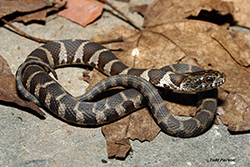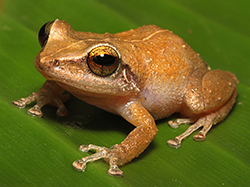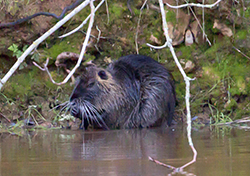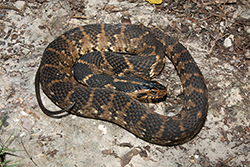
Northern watersnakes are native to the eastern United States. A breeding population was discovered in Placer County in 2007 and a second population confirmed in 2014. Photo courtesy of Todd Pierson.

Coqui frogs have appeared periodically in Southern California. The first coqui was collected from a private residence in Orange County in 2012 and arrived on a tropical house plant.

Nutria have been confirmed in six central California counties, including Tuolumne County where this nutria was photographed near Don Pedro Reservoir in 2017. Photo courtesy of Peggy Sells.

Southern watersnakes are native to the southeastern United States and can reach lengths of 5 feet. They have been found in Yolo, Sacramento and Los Angeles counties. Photo courtesy of Todd Pierson.
Six months after announcing the discovery of a breeding population of invasive nutria in the San Joaquin Valley, CDFW’s Invasive Species “hotline” continues to receive multiple reports each week of nutria sightings from the public.
The reports come in on the toll-free line – (866) 440-9530 – or its e-mail counterpart – Invasives@wildlife.ca.gov – and numbers have reached as many as 30 e-mails and nine calls in a day.
The hotline accounts are checked each weekday – and often multiple times a day. CDFW attempts to respond to every individual submission. To date, about 95 percent of the nutria reports have turned out to be false – either sightings of other wildlife mistaken for nutria or reports that lack enough information to confirm one way or another.
“If it’s on your roof or chewing up the wires in your car, it’s not a nutria,” said Helen Benson, an environmental scientist with CDFW’s Invasive Species Program.
The misidentification of nutria is understandable. Nutria closely resemble several species of native and non-native wildlife, including muskrats, beavers, and rats, which adds to the challenge of a positive identification. Nutria are semi-aquatic rodents native to South America that haven’t been seen in California for 40 years until the spring of 2017 when a pregnant female turned up in a beaver trap.
Still, CDFW welcomes and encourages all reported sightings, preferably accompanied by a photo or video to help verify the identity.
In April, the hotline received one of its most important tips when an Animal Services officer with the City of Lathrop called to report catching and releasing a nutria – without realizing what it was at the time. The officer took photos of the animal, however, which became the second nutria confirmed in San Joaquin County on the edge of the Delta.&
CDFW has focused its early eradication efforts on keeping nutria out of the Delta, where their destructive burrowing into levees, ditches, canals and other water infrastructure could jeopardize the Delta’s flood control and water conveyance systems. CDFW has since launched nutria surveillance and eradication operations in the Delta to mirror those occurring farther south in the San Joaquin Valley.
While CDFW’s Benson estimates that about 80 percent of the Invasive Species hotline’s reports involve nutria these days, the hotline itself predates the nutria infestation by more than a decade. It was created in 2007 to help combat another invasive species crisis: the discovery of quagga and zebra mussels in California.
“Most people don’t realize that invasive species are the second-greatest threat to native species after habitat loss,” Benson said.
It’s easier to combat and possibly eliminate invasive species early before populations become entrenched, which explains CDFW’s aggressive nutria eradication response.
Coqui frogs are another invasive species dealt with quickly when reports come into the hotline. The voracious, tiny tree frogs native to Puerto Rico, Central and South America emit a deafening raucous that belies their small size. The call from one of these tiny amphibians can reach noise levels of 80 to 90 decibels – the same as a running lawnmower. Colonies of coqui frogs have been blamed for lowering property values on Hawaii’s Big Island.
Coqui frogs have turned up in Southern California, arriving in nursery plant shipments from Hawaii and other exotic locales. CDFW asks those contacting the hotline to record the frogs’ calls for confirmation, at which point CDFW will dispatch biologists to catch and remove the frogs.
The Invasive Species hotline has also proved helpful in combatting two invasive aquatic snakes that have turned up in Northern California – the northern watersnake and southern watersnake – likely released into the environment by disenchanted owners who acquired them as pets. Their ill temperament and unpleasant odor make them poor pets – along with the fact they are illegal to possess in California without a permit. CDFW has launched trapping efforts in the suburban Sacramento communities of Roseville and Folsom, where breeding populations of the snakes have been confirmed. It’s possible these snakes could find their way to backyard ponds and swimming pools, and reports to the hotline would help CDFW’s efforts to eradicate them.
Invasive species are a persistent threat to California, and the public plays an important role in helping CDFW identify and respond to new threats. Whether in their backyard or hiking their favorite trail, everyday citizens across the state are partners in protecting their natural resources by reporting unfamiliar plants and animals they don’t recognize.
CDFW Photos. Top Photo: Juvenile Coqui frog.